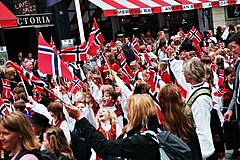Syttende Mai
| 17th May Constitution Day |
|
|---|---|

Children's parade in Oslo, 2010
|
|
| Also called | Syttende mai (bokmål), Syttande mai (nynorsk) or Søttende mai (old) (May 17) |
| Observed by | Norwegians |
| Type | National |
| Significance | Celebrating the signing of the Norwegian Constitution in Eidsvoll, May 17, 1814. |
| Celebrations | Parades, flags |
| Date | May 17 |
| Next time | 17 May 2018 |
| Frequency | annual |
| Related to |
Constitution of Norway Norwegian Constituent Assembly Union Dissolution Day (7 June) |
Norwegian Constitution Day is the National Day of Norway and is an official national holiday observed on May 17 each year. Among Norwegians, the day is referred to simply as syttende mai (lit. "seventeenth May"), Nasjonaldagen (The National Day) or Grunnlovsdagen (The Constitution Day), although the latter is less frequent.
The Constitution of Norway was signed at Eidsvoll on May 17 in the year 1814. The constitution declared Norway to be an independent kingdom in an attempt to avoid being ceded to Sweden after Denmark–Norway's devastating defeat in the Napoleonic Wars.
The celebration of this day began spontaneously among students and others from early on. However, Norway was at that time in a union with Sweden (following the Convention of Moss in August 1814) and for some years the King of Sweden and Norway was reluctant to allow the celebrations. For a few years during the 1820s, King Karl Johan actually banned it, believing that celebrations like this were in fact a kind of protest and disregard — even revolt — against the union. The king's attitude changed after the Battle of the Square in 1829, an incident which resulted in such a commotion that the king had to allow commemorations on the day. It was, however, not until 1833 that public addresses were held, and official celebration was initiated near the monument of former government minister Christian Krohg, who had spent much of his political life curbing the personal power of the monarch. The address was held by Henrik Wergeland, thoroughly witnessed and accounted for by an informant dispatched by the king himself.
After 1864 the day became more established when the first children's parade was launched in Christiania, at first consisting only of boys. This initiative was taken by Bjørnstjerne Bjørnson, although Wergeland made the first known children's parade at Eidsvoll around 1820. It was only in 1899 that girls were allowed to join in the parade for the first time. In 1905, the union with Sweden was dissolved and Prince Carl of Denmark was chosen to be King of an independent Norway, under the name Haakon VII. Obviously, this ended any Swedish concern for the activities of the National Day.
...
Wikipedia
